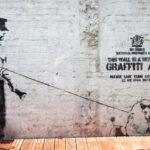While I have been surrounded by graffiti art for most of my youth I strangely knew very little about the history of this artform. How it has gone from an offensive burden to not only being an acceptable art form but one championed and heralded as a major asset for the city. To understand this transformation and as part of my secondary research I watched three documentaries on street graffiti art in the UK.
Bombin
The first was a 1987 Channel 4 documentary entitled ‘Bombin’ directed by Dick Fontaine (add embedded video). When graffiti street art first migrated over to the UK in the late 80s from the US, many ridiculed it as an artform. The authorities regarded almost all forms of street graffiti art from the late 80s through to the early 2000s as a form of criminal damage and not ‘art’. This meant for the majority of street artists at the time most of their early work was created in secret or in disguise, with constant risk of arrest, fines and imprisonment. What was clear from the ‘Bombin’ documentary was that the immediate opposition to this form of artistic expression forced it to become an illegal secretive underground subculture. It remained this way for years making it very difficult for artists to move away from the anti-social criminal label or have their work respected and accepted as an art form. The documentary featured Brim Fuentes, a Bronx graffiti artist, who started graffiti ‘bombin’ (tagging) in the New York subway in one the most important periods of graffiti history. He is recognised as the first graffiti artist to visit and influence artists in the UK. The documentary also features Robert Del Naja, also known as “3D” who is now part of the music collective Massive Attack and the Drum n’ Base/jungle musician Goldie who started off as graffiti artists. It explores their involvement in UK street art subculture in the late 80s/early 90s
At this time, in spite of its illegality, there were a few people in the so called art establishment who recognised and embraced graffiti art as a new urban artform. The combination of the emerging UK hip-hop, trip-hop and acid house music cultures alongside street graffiti thus opened doors to, and inspired, a whole generation of young British street artists, many of whom went onto make their careers from their art and many are still active today.
Drawing the Line
The next documentary I watched was the 1989 BBC production entitled ‘Drawing the Line’ which focused on the Bristol street art scene in the late 80s. It features the prominent Bristol Street artists Inkie, 3D and the youth worker John Nation, dubbed the ‘graff-father’, who provided graffiti artists with their first legal space in which to practice their art without being criminalized. A large part of the documentary focuses on ‘Operation Anderson’ and its consequences. This Bristol and South West police operation raided the homes of 70 graffiti artists and impounded their sketches and materials, imposed fines etc. It was the biggest anti-graffiti operation in the UK and aimed to force the subculture into retirement, but it only served to attract more street artists to locate to Bristol.
Vandals and Visionaries
The third documentary entitled ‘Vandals and Visionaries’ is a BBC production filmed in 2017 and acts in many ways as a follow up piece to the 1989 documentary. It features, 28 years on, many of the same street artists and shows how dramatically the street art scene, in Bristol in particular, has been transformed. It explores how Graffiti art has gone from being seen as unwanted social ill from America to part of Bristol’s heritage. It revisits John Nation and Inkie but also features other contemporary Bristol street artists such as Nick Walker, Felix Braun and Cheo who are now internationally acclaimed artists. Police are interviewed and city authorities explain their new approach to street art. While tagging is still seen as a criminal offense, street art is now treated differently, it is seen as being of value and as long as the owner of the surface being used does not request police intervention, the artwork is permitted.
In watching these documentaries I have gained new insights into how the narrative of graffiti street art has been challenged and changed over the decades. For my next blog I want to go on to explore how these changing public and police attitudes have affected the way that street artists are recognised and rewarded for their work and whether this has compromised the integrity of the artform.






